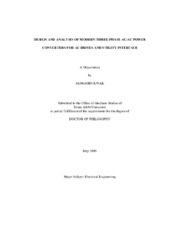| dc.description.abstract | Significant advances in modern ac/ac power converter technologies and demands
of industries have reached beyond standard ac/ac power converters with voltage-source
inverters fed from diode rectifiers. Power electronics converters have been matured to
stages toward compact realization, increased high-power handling capability, and
improving utility interface. Modern ac/ac power converter topologies with various
control strategies have been introduced for the further improvements, such as matrix
converters, current-fed converters, PWM rectifiers, and active power filters. In this
dissertation, several new converter topologies are proposed in conjunction with
developed control schemes based on the modern ac/ac converters which enhance
performance and solve the drawbacks of conventional converters.
In this study, a new fault-tolerant PWM strategy is first proposed for matrix
converters. The added fault-tolerant scheme would strengthen the matrix converter
technology for aerospace and military applications. A modulation strategy is developed
to reshape output currents for continuous operation, against fault occurrence in matrix
converter drives.
This study designs a hybrid, high-performance ac/ac power converter for high
power applications, based on a high-power load commutated inverter and a mediumpower
voltage source inverter. Natural commutation of the load commutated inverter is
actively controlled by the voltage source inverter. In addition, the developed hybrid
system ensures sinusoidal output current/voltage waveforms and fast dynamic response
in high power areas.
A new topology and control scheme for a six-step current source inverter is
proposed. The proposed topology utilizes a small voltage source inverter, to turn off
main thyristor switches, transfer reactive load energy, and limit peak voltages across
loads. The proposed topology maximizes benefits of the constituent converters: highpower
handling capability of large thyristor-based current source inverters as well as fast
and easy control of small voltage source inverters.
This study analyzes, compares, and evaluates two topologies for unity power
factor and multiple ac/ac power conversions. Theoretical analyses and comparisons of
the two topologies, grounded on mathematical approaches, are presented from the
standpoint of converter kVA ratings, dc-link voltage requirements, switch ratings,
semiconductor losses, and reactive component sizes. Analysis, simulation, and
experimental results are detailed for each proposed topology. | en |


